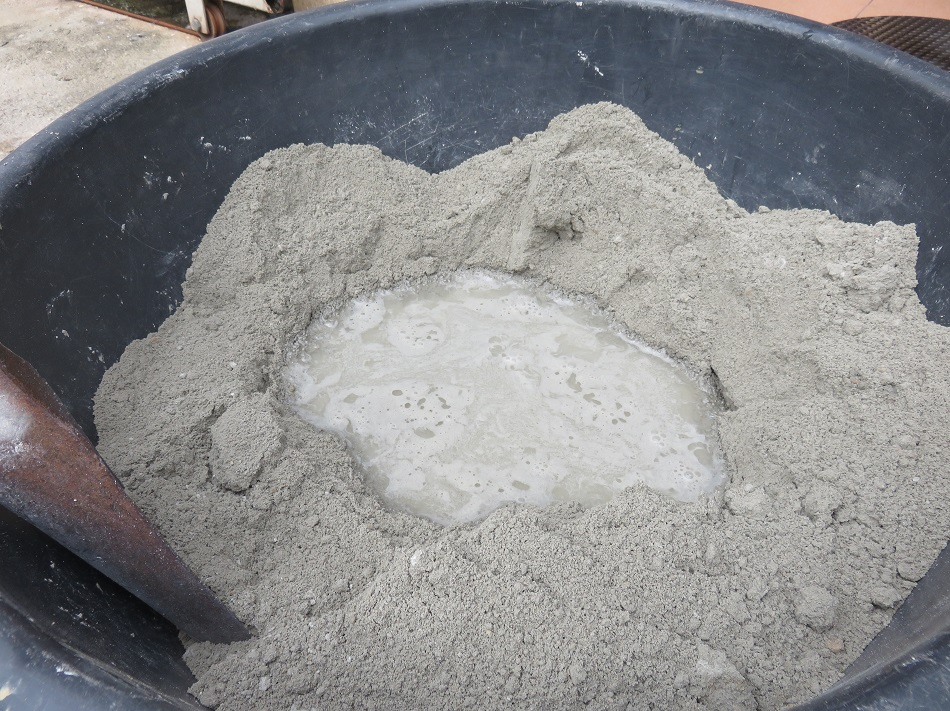
Image Credit: AppleDK/Shutterstock.com
Portland cement is the most common type of cement. It is used globally as a basic ingredient of concrete, mortar, stucco, and non-specialty grout. It consists of finely divided calcareous materials (lime containing) and argillaceous materials (clay). Compounds that contribute more than 90% of the dry weight of the cement are tricalcium silicate, dicalcium silicate, tricalcium aluminate, and tetracalcium aluminoferrite.
The addition of water to cement (exothermic reaction) leads to the formation of new compounds. This hydrated cement paste comprises of tobermorite gel, calcium hydroxide, calcium aluminoferrite hydrate, tetracalcium aluminate hydrate, and calcium monosulfoaliminate.
Typically, a mature cement paste consists of 70–80% layered calcium-silicate-hydrate (C-S-H) gel, 20% Ca(OH)2, and other chemical compounds. The structure of C-S-H gel has three types of groups that contribute to bonds across surfaces or in the interlayer of partly crystallized tobermorite material: calcium ions, siloxanes, and water molecules.
Bonding of the water within the layers (gel water) with other groups through hydrogen bonds determines the strength, stiffness, and creep properties of the cement paste. The structural properties of the cement paste are chiefly provided by tobermorite gel.
Effects of Temperature on Cement Paste
Upon heating, the cement paste undergoes an incessant sequence of irreversible decomposition reactions. Under the influence of high-temperature, certain physical and chemical changes occur that lead to shrinkage, transient creep, and changes in the strength of the Portland cement paste.
The changes that are observed in the material features under this temperature are its moisture state (sealed or unsealed), chemical structure (loss of chemically bound water from the C-S-H in the unsealed condition, CaO/SiO2 ratio of the hydrate in the sealed condition, and amount of Ca(OH)2 crystals in sealed or unsealed conditions), and physical structure (total pore volume including cracks, average pore size, and amorphous/crystalline structure of solid).
Further, when the cement paste is exposed to high temperatures, decomposition of portlandite (calcium hydroxide) and calcium silicate hydrates occurs. However, there is a contradiction in the literature about the nature and types of decomposition products of C-S-H gel which decomposes over a wide range of temperatures (105 ˚C to 1000 ˚C) owing to its amorphous nature.
Several researchers examined the dehydration of C-S-H gel in cement paste exposed to high temperatures. C-S-H gel dehydrates in the temperature range of 100 ˚C - 400 ˚C and transforms to C2S and C3S at 800 ˚C. It was also reported that C-S-H gel started to decompose at 560 ˚C and transformed to C2S and C3S at 800 ˚C.
The weight loss of cement pastes occurs at temperatures between 300 ˚C - 750 ˚C. Weight loss increases with temperature.
Weight loss that happens at 300 ˚C maybe because of the evaporation of capillary water from macro capillary pores, evaporation of gel water from gel pores of cement paste and partial dehydration of C-S-H. Weight loss of cement paste at 450 ˚C may be due to the dehydration of portlandite. Weight loss that occurs at 600 ˚C - 750 ˚C is because of the dehydration of residual portlandite and C-S-H as well as decomposition of calcite.
Bulk density sharply reduces at 300 ˚C then decreases very slowly at higher temperatures. Total porosity decreases at 300 ˚C and then increases at higher temperatures. With the increase in the temperature to 300 ˚C, the vapor produced from the evaporation of capillary water and dehydration of calcium hydrates accumulates whilst the total porosity decreases. Thereby, an internal vapor pressure builds up inside the low permeable cement paste.
In this hydrothermal condition, vapor pressure boosts the hydration of unhydrated cement paste and formation of additional hydration products and also fills up some of the open pores of the cement paste.
FTIR, XRD, TGA/DTA and, SEM techniques are used to monitor the microstructural and compositional changes within cement paste that occur with rising temperatures. No significant changes happen to the microstructure of cement paste at 300 ˚C. However, the thermal shock that develops due to the cooling of the heated cement paste and the rehydration of lime results in a significant increase in volume that enhances the propagation of harmful cracks.
Sources and Further Reading
- Alarcon-Ruiz, L., Platret, G., Massieu, E., and Ehrlacher, A. (2005). The Use of Thermal Analysis in Assessing the Effect of Temperature on a Cement Paste. Cement and Concrete Research. 35. 609613.
- Tantawy, M. A. (2017). Effect of High Temperatures on the Microstructure of Cement Paste. Journal of Materials Science and Chemical Engineering, 5, 33-48.
Disclaimer: The views expressed here are those of the author expressed in their private capacity and do not necessarily represent the views of AZoM.com Limited T/A AZoNetwork the owner and operator of this website. This disclaimer forms part of the Terms and conditions of use of this website.